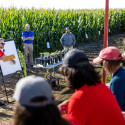Researchers identify key player in respiratory memory
By studying the “memory” of the respiratory system, a group of researchers from the UW–Madison has identified a key player – a protein called BDNF that’s involved in learning – responsible for the body’s ability to keep breathing properly, despite the challenges it may face.
The findings, published Dec. 14 in the online edition of Nature Neuroscience, could provide ideas of new drug targets, which could lead to new treatments for or ways to prevent a number of potentially fatal breathing disorders, including sleep apnea, sudden infant death syndrome and some related to spinal cord injuries, according to the researchers.
Every few seconds, we draw a breath and then release it. If for some reason this routine is interrupted – oxygen levels are low or airways are blocked, for example – our bodies respond accordingly. In the case of oxygen deprivation, the nerve cells in the brain send messages to motor neurons along the spine, which then tell certain muscles involved in breathing to work harder. As a result, a person may take deeper breaths.
If the breathing disruption is experienced regularly, the respiratory system remembers the disruption and most likely will respond more vigorously in the future. Researchers call this change in neural behavior “neuro-plasticity.”
In some cases, however, the respiratory system may not remember, says Gordon Mitchell, chair of the comparative biosciences department at UW–Madison’s School of Veterinary Medicine and senior author of the recent paper. He notes that some people who have sleep apnea – a disorder where breathing stops repeatedly during sleep – may have inadequate respiratory memories. He adds that individuals with spinal cord injuries in the neck often must rely on ventilators to help them breathe.
“For them, breathing is a bigger problem than never walking again,” says Mitchell. “To breathe is to live.”
To allow such patients to breathe more easily, Mitchell and others are exploring the mechanisms underlying respiratory memory so as to find ways to enhance it, such as through drugs.
“If we can understand how breathing changes as a result of experience, we can develop techniques to intervene when breathing is compromised,” says Tracy Baker-Herman, a postdoctoral fellow at UW–Madison and first author of the paper.
To begin to uncover these mechanisms, the researchers exposed rats to three five-minute intervals of hypoxia, or decreased oxygen. Sixty minutes after exposure, they recorded the respiratory-related activity levels in the phrenic nerve, which controls the diaphragm muscle. If the activity levels increased after exposure, the researchers would know that the respiratory system, specifically this nerve, had developed a memory of low oxygen.
The Wisconsin scientists did, in fact, record this memory: Activity levels after exposure were 80 percent higher than before the intervals started, suggesting that this nerve remembered experiencing periods of low oxygen levels, says Mitchell.
Making this connection, however, was not enough, says Baker-Herman.
The researchers wanted to know what caused this memory. So, they analyzed segments of spinal cord taken from rats after they had been exposed for 60 minutes to either normal or decreased amounts of oxygen.
The researchers looked specifically for changes in the BDNF protein, or brain derived neurotrophic factor, which is known to sustain and even stimulate neuronal function in the brain. The findings show that intermittent periods of decreased oxygen increased concentrations of the BDNF protein in the phrenic nerve by 56 percent.
Through further testing, the researchers learned that BDNF is, in fact, responsible for increasing activity in this nerve, thereby stimulating a respiratory memory. For example, when the researchers blocked BDNF production in rats with a new technique known as RNA interference and then exposed the rats to intervals of decreased oxygen, they observed no increase in nerve activity. But, when they injected the protein directly into the phrenic nerve of rats they found that neuronal activity increased by 125 percent.
Both findings, says Mitchell, point to the integral role BDNF plays in enhancing the respiratory system’s response to disruptions in breathing. “They show causality between BDNF and phrenic long-term facilitation (or memory),” he says, adding, “the role of BDNF in respiratory plasticity was not known at all before now.”
With this new information, Mitchell, Baker-Herman and others in their group continue to search for additional players in respiratory memory. “The closer we get to the ultimate cause,” says Mitchell, “the better the chance of developing new pharmaceutical therapies.”
These therapies would have the potential not only to restore breathing ability to individuals struck with devastating spinal cord injuries, but also to alleviate the effects of sleep apnea – tiredness, learning impairments, high blood pressure, even death – among the 5 percent of the population with this breathing disorder. Mitchell adds, “The promise for treating other disorders where breathing is disrupted, including sudden infant death syndrome and ALS (Amyotrophic Lateral Sclerosis or Lou Gehrig’s disease) is not trivial.”
But he cautions that the basic science behind these disorders is still being learned and that pharmacological treatments will follow only after that knowledge has been gained.
Tags: research




